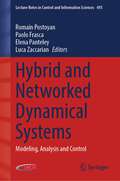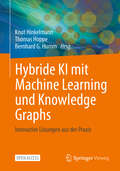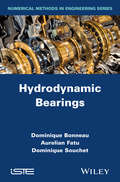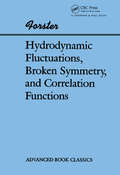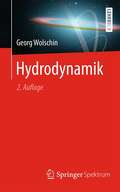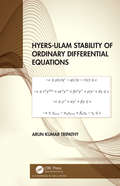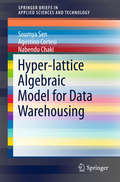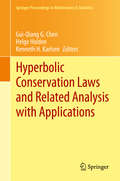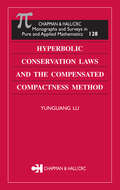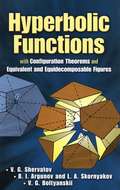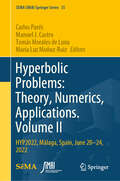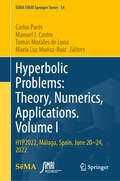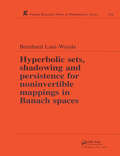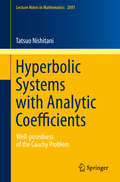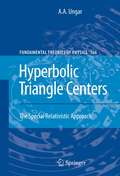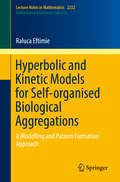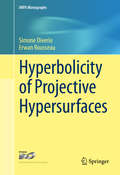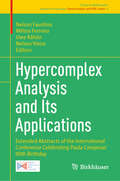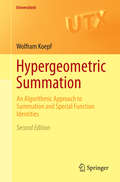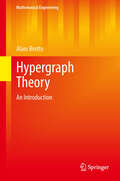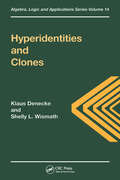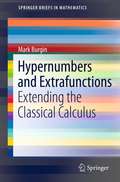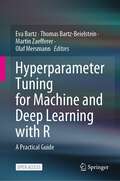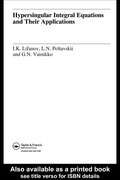- Table View
- List View
Hybrid and Networked Dynamical Systems: Modeling, Analysis and Control (Lecture Notes in Control and Information Sciences #493)
by Luca Zaccarian Elena Panteley Paolo Frasca Romain PostoyanHybrid and Networked Dynamical Systems treats a class of systems that is ubiquitous in everyday life. From energy grids to fleets of robots or vehicles to social networks to biological networks, the same scenario arises: dynamical units interact locally through a connection graph to achieve a global task. The book shows how analysis and design tools can be adapted for control applications that combine the effects of network-induced interactions and hybrid dynamics with complex results.Following a scene-setting introduction, the remaining 12 chapters of the book are divided into three parts and provide a unique opportunity to describe the big picture that is the culmination of years of recent research activity. The contributing authors expand on their ideas at greater length than is possible in an archival research paper and use in-depth examples to illustrate their theoretical work.The widespread importance of hybrid and networked systems means that the book is of significant interest to academic researchers working in applied mathematics, control, and electrical, mechanical and chemical engineering and to their industrial counterparts.
Hybride KI mit Machine Learning und Knowledge Graphs: Innovative Lösungen aus der Praxis
by Thomas Hoppe Knut Hinkelmann Bernhard G. HummSeit den 2010er Jahren hat die Künstliche Intelligenz (KI) durch Erfolge im Machine Learning (ML) einen enormen Schub erfahren. Einerseits durch die stark angewachsene Menge verfügbarer digitaler Daten und andererseits durch Innovationen im Bereich der Künstlichen Neuronalen Netze und des Deep Learning (DL). Wissensbasierte KI umfasst neben traditionellen Expertensystemen und Regelsystemen auch die Technologien und Standards, welche im Rahmen der Semantic Web Initiative seit den 1990er Jahren entwickelt wurden. Sie ermöglichten unter anderem die Entwicklung umfangreicher Knowledge Graphs (Wissensnetze). Hybride KI Ansätze kombinieren Machine Learning und wissensbasierte KI. Da sie als erfolgversprechend gelten, werden sie seit Jahren erforscht. Dieser Sammelband zeigt, wie innovative hybride KI-Verfahren bereits heute erfolgreich in der Praxis eingesetzt werden. Dies ist ein Open Access-Buch.
Hydrodynamic Bearings
by Dominique Bonneau Aurelian Fatu Dominique SouchetThis Series provides the necessary elements to the development and validation of numerical prediction models for hydrodynamic bearings. This book describes the rheological models and the equations of lubrication. It also presents the numerical approaches used to solve the above equations by finite differences, finite volumes and finite elements methods.
Hydrodynamic Fluctuations, Broken Symmetry, And Correlation Functions (Frontiers in Physics)
by Dieter ForsterFrom the Preface: "The purpose of this book is to present and apply a language and to discuss methods which make it very convenient to exploit such analogies, and which are uniquely suited to describe and explain non-equilibrium phenomena in a rich variety of many-particle systems: the language of time correlation functions and linear response theory."
Hydrodynamik
by Georg WolschinDieses Buch stellt ausgehend von der Kontinuitätsgleichung, den Eulergleichungen und der Adiabatengleichung zunächst die Hydrodynamik idealer Fluide dar. Die Behandlung von viskosen Fluiden und den entsprechend modifizierten Grundgleichungen erfolgt über die Navier-Stokes-Gleichungen und die Wärmetransportgleichung, welche die Energiedissipation in realen Fluiden beschreiben. Außerdem werden Diffusionsprozesse in inhomogenen Fluiden und bei der Brown’schen Bewegung untersucht. Diffusion spielt auch bei der Teilchenerzeugung in relativistischen Kollisionen von Bleikernen am LHC eine wichtige Rolle. Eine Lorentz-invariante relativistische Formulierung der Hydrodynamik wird ebenfalls präsentiert. Kapitel über Anwendungen der Hydrodynamik in der Astrophysik und auf Superfluide wie Helium bei tiefen Temperaturen runden diese Einführung in ein breites und modernes Forschungsgebiet ab. Die Neuauflage enthält zusätzlich ein Kapitel über nichtlineare Diffusionsprozesse in fermionischen und bosonischen Systemen mit ihrer Anwendung auf die Bildung von Bose-Einstein-Kondensaten bei niedrigen Energien und Temperaturen sowie auf die lokale Equilibrierung von Quarks und Gluonen in Schwerionenkollisionen bei hohen relativistischen Energien. Testaufgaben am Ende des Buchs motivieren den Leser, sich den Stoff aktiv anzueignen. Der Autor liefert mit diesem Werk eine kurze Einführung für Physikstudierende in die Hydrodynamik. Doch auch Promovierende und Wissenschaftler finden in den fortgeschrittenen Teilen eine gute Hinführung zu aktuellen Forschungsfragestellungen.
Hyers-Ulam Stability of Ordinary Differential Equations
by Arun Kumar TripathyHyers-Ulam Stability of Ordinary Differential Equations undertakes an interdisciplinary, integrative overview of a kind of stability problem unlike the existing so called stability problem for Differential equations and Difference Equations. In 1940, S. M. Ulam posed the problem: When can we assert that approximate solution of a functional equation can be approximated by a solution of the corresponding equation before the audience at the University of Wisconsin which was first answered by D. H. Hyers on Banach space in 1941. Thereafter, T. Aoki, D. H. Bourgin and Th. M. Rassias improved the result of Hyers. After that many researchers have extended the Ulam's stability problems to other functional equations and generalized Hyer's result in various directions. Last three decades, this topic is very well known as Hyers-Ulam Stability or sometimes it is referred Hyers-Ulam-Rassias Stability. This book synthesizes interdisciplinary theory, definitions and examples of Ordinary Differential and Difference Equations dealing with stability problems. The purpose of this book is to display the new kind of stability problem to global audience and accessible to a broader interdisciplinary readership for e.g those are working in Mathematical Biology Modeling, bending beam problems of mechanical engineering also, some kind of models in population dynamics. This book may be a starting point for those associated in such research and covers the methods needed to explore the analysis. Features: The state-of-art is pure analysis with background functional analysis. A rich, unique synthesis of interdisciplinary findings and insights on resources. As we understand that the real world problem is heavily involved with Differential and Difference equations, the cited problems of this book may be useful in a greater sense as long as application point of view of this Hyers-Ulam Stability theory is concerned. Information presented in an accessible way for students, researchers, scientists and engineers.
Hyper-lattice Algebraic Model for Data Warehousing
by Nabendu Chaki Soumya Sen Agostino CortesiThis book presents Hyper-lattice, a new algebraic model for partially ordered sets, and an alternative to lattice. The authors analyze some of the shortcomings of conventional lattice structure and propose a novel algebraic structure in the form of Hyper-lattice to overcome problems with lattice. They establish how Hyper-lattice supports dynamic insertion of elements in a partial order set with a partial hierarchy between the set members. The authors present the characteristics and the different properties, showing how propositions and lemmas formalize Hyper-lattice as a new algebraic structure.
Hyperbolic Conservation Laws and Related Analysis with Applications
by Kenneth H. Karlsen Helge Holden Gui-Qiang G. ChenThis book presents thirteen papers, representing the most significant advances and current trends in nonlinear hyperbolic conservation laws and related analysis with applications. Topics covered include a survey on multidimensional systems of conservation laws as well as novel results on liquid crystals, conservation laws with discontinuous flux functions, and applications to sedimentation. Also included are articles on recent advances in the Euler equations and the Navier-Stokes-Fourier-Poisson system, in addition to new results on collective phenomena described by the Cucker-Smale model. The Workshop on Hyperbolic Conservation Laws and Related Analysis with Applications at the International Centre for Mathematical Sciences (Edinburgh, UK) held in Edinburgh, September 2011, produced this fine collection of original research and survey articles. Many leading mathematicians attended the event and submitted their contributions for this volume. It is addressed to researchers and graduate students interested in partial differential equations and related analysis with applications.
Hyperbolic Conservation Laws and the Compensated Compactness Method
by Yunguang LuThe method of compensated compactness as a technique for studying hyperbolic conservation laws is of fundamental importance in many branches of applied mathematics. Until now, however, most accounts of this method have been confined to research papers. Offering the first comprehensive treatment, Hyperbolic Conservation Laws and the Compensated Comp
Hyperbolic Functions with Configuration Theorems and Equivalent and Equidecomposable Figures
by V. G. Shervatov B. I. Argunov L. A. Skornyakov V. G. BoltyanskiiThis single-volume compilation of three books centers on Hyperbolic Functions, an introduction to the relationship between the hyperbolic sine, cosine, and tangent, and the geometric properties of the hyperbola. The development of the hyperbolic functions, in addition to those of the trigonometric (circular) functions, appears in parallel columns for comparison. A concluding chapter introduces natural logarithms and presents analytic expressions for the hyperbolic functions.The second book, Configuration Theorems, requires only the most elementary background in plane and solid geometry. It discusses several interesting theorems on collinear points and concurrent lines, showing their applications to several practical geometric problems, and thus introducing certain fundamental concepts of projective geometry. Equivalent and Equidecomposable Figures, the final book, discusses the mathematical conditions of dissecting a given polyhedron into a finite number of pieces and reassembling them into another given polyhedron.
Hyperbolic Manifolds
by Albert MardenOver the past three decades there has been a total revolution in the classic branch of mathematics called 3-dimensional topology, namely the discovery that most solid 3-dimensional shapes are hyperbolic 3-manifolds. This book introduces and explains hyperbolic geometry and hyperbolic 3- and 2-dimensional manifolds in the first two chapters and then goes on to develop the subject. The author discusses the profound discoveries of the astonishing features of these 3-manifolds, helping the reader to understand them without going into long, detailed formal proofs. The book is heavily illustrated with pictures, mostly in color, that help explain the manifold properties described in the text. Each chapter ends with a set of exercises and explorations that both challenge the reader to prove assertions made in the text, and suggest further topics to explore that bring additional insight. There is an extensive index and bibliography.
Hyperbolic Problems: HYP2022, Málaga, Spain, June 20-24, 2022 (SEMA SIMAI Springer Series #35)
by Carlos Parés María Luz Muñoz-Ruiz Manuel J. Castro Tomás Morales de LunaThe present volume contains a selection of papers from the XVIII International Conference on Hyperbolic Problems: Theory, Numerics, and Applications (HYP2022), which was held on June 20-24, 2022 in Málaga (Spain). The goal of this series of conferences is to bring together scientists with interests in the theoretical, applied, and computational aspects of hyperbolic partial differential equations (systems of hyperbolic conservation laws, wave equations, etc.) and of related mathematical models. The chapters in this volume correspond to selected contributions related to numerical aspects and applications.
Hyperbolic Problems: HYP2022, Málaga, Spain, June 20–24, 2022 (SEMA SIMAI Springer Series #34)
by Carlos Parés María Luz Muñoz-Ruiz Manuel J. Castro Tomás Morales de LunaThe present volume contains a selection of papers from the XVIII International Conference on Hyperbolic Problems: Theory, Numerics, and Applications (HYP2022), which was held on June 20-24, 2022 in Málaga (Spain). The goal of this series of conferences is to bring together scientists with interests in the theoretical, applied, and computational aspects of hyperbolic partial differential equations (systems of hyperbolic conservation laws, wave equations, etc.) and of related mathematical models. The chapters in this volume correspond to some of the plenary lectures and to selected contributions related to theoretical aspects.
Hyperbolic Sets, Shadowing and Persistence for Noninvertible Mappings in Banach Spaces
by Bernard Lani-WaydaThis text gives a self-contained and detailed treatment of presently known results, and new theorems on hyperbolicity, shadowing, complicated motion, and robustness. The book is intended to provide a dependable reference for researchers wishing to apply such results. This book will be of particular interest to researchers and students interested in dynamical systems, particularly in noninvertible maps and infinite dimensional semi-flows or maps and global analysis.
Hyperbolic Systems with Analytic Coefficients
by Tatsuo NishitaniThis monograph focuses on the well-posedness of the Cauchy problem for linear hyperbolic systems with matrix coefficients. Mainly two questions are discussed: (A) Under which conditions on lower order terms is the Cauchy problem well posed? (B) When is the Cauchy problem well posed for any lower order term? For first order two by two systems with two independent variables with real analytic coefficients, we present complete answers for both (A) and (B). For first order systems with real analytic coefficients we prove general necessary conditions for question (B) in terms of minors of the principal symbols. With regard to sufficient conditions for (B), we introduce hyperbolic systems with nondegenerate characteristics, which contain strictly hyperbolic systems, and prove that the Cauchy problem for hyperbolic systems with nondegenerate characteristics is well posed for any lower order term. We also prove that any hyperbolic system which is close to a hyperbolic system with a nondegenerate characteristic of multiple order has a nondegenerate characteristic of the same order nearby.
Hyperbolic Triangle Centers: The Special Relativistic Approach
by A. A. UngarAfter A. Ungar had introduced vector algebra and Cartesian coordinates into hyperbolic geometry in his earlier books, along with novel applications in Einstein's special theory of relativity, the purpose of his new book is to introduce hyperbolic barycentric coordinates, another important concept to embed Euclidean geometry into hyperbolic geometry. It will be demonstrated that, in full analogy to classical mechanics where barycentric coordinates are related to the Newtonian mass, barycentric coordinates are related to the Einsteinian relativistic mass in hyperbolic geometry. Contrary to general belief, Einstein's relativistic mass hence meshes up extraordinarily well with Minkowski's four-vector formalism of special relativity. In Euclidean geometry, barycentric coordinates can be used to determine various triangle centers. While there are many known Euclidean triangle centers, only few hyperbolic triangle centers are known, and none of the known hyperbolic triangle centers has been determined analytically with respect to its hyperbolic triangle vertices. In his recent research, the author set the ground for investigating hyperbolic triangle centers via hyperbolic barycentric coordinates, and one of the purposes of this book is to initiate a study of hyperbolic triangle centers in full analogy with the rich study of Euclidean triangle centers. Owing to its novelty, the book is aimed at a large audience: it can be enjoyed equally by upper-level undergraduates, graduate students, researchers and academics in geometry, abstract algebra, theoretical physics and astronomy. For a fruitful reading of this book, familiarity with Euclidean geometry is assumed. Mathematical-physicists and theoretical physicists are likely to enjoy the study of Einstein's special relativity in terms of its underlying hyperbolic geometry. Geometers may enjoy the hunt for new hyperbolic triangle centers and, finally, astronomers may use hyperbolic barycentric coordinates in the velocity space of cosmology.
Hyperbolic and Kinetic Models for Self-organised Biological Aggregations: A Modelling and Pattern Formation Approach (Lecture Notes in Mathematics #2232)
by Raluca EftimieThis book focuses on the spatio-temporal patterns generated by two classes of mathematical models (of hyperbolic and kinetic types) that have been increasingly used in the past several years to describe various biological and ecological communities. Here we combine an overview of various modelling approaches for collective behaviours displayed by individuals/cells/bacteria that interact locally and non-locally, with analytical and numerical mathematical techniques that can be used to investigate the spatio-temporal patterns produced by said individuals/cells/bacteria. Richly illustrated, the book offers a valuable guide for researchers new to the field, and is also suitable as a textbook for senior undergraduate or graduate students in mathematics or related disciplines.
Hyperbolicity of Projective Hypersurfaces
by Simone Diverio Erwan RousseauThisbook presents recent advances on Kobayashi hyperbolicity in complex geometry,especially in connection with projective hypersurfaces. This is a very activefield, not least because of the fascinating relations with complex algebraicand arithmetic geometry. Foundational works of Serge Lang and Paul A. Vojta,among others, resulted in precise conjectures regarding the interplay of theseresearch fields (e. g. existence of Zariski dense entire curves shouldcorrespond to the (potential) density of rational points). Perhapsone of the conjectures which generated most activity in Kobayashi hyperbolicitytheory is the one formed by Kobayashi himself in 1970 which predicts that avery general projective hypersurface of degree large enough does not containany (non-constant) entire curves. Since the seminal work of Green and Griffithsin 1979, later refined by J. -P. Demailly, J. Noguchi, Y. -T. Siu and others, itbecame clear that a possible general strategy to attack this problem was tolook at particular algebraic differential equations (jet differentials) thatevery entire curve must satisfy. This has led to some several spectacularresults. Describing the state of the art around this conjecture is the maingoal of this work.
Hypercomplex Analysis and Its Applications: Extended Abstracts of the International Conference Celebrating Paula Cerejeiras’ 60th Birthday (Trends in Mathematics #9)
by Uwe Kähler Nelson Faustino Milton Ferreira Nelson VieiraThis book contains a collection of short papers based on the presentations given at the international conference on Hypercomplex Analysis and its Applications celebrating Paula Cerejeiras&’ 60th birthday. These papers present the latest results as well as overviews on specific topics in the areas of hypercomplex and harmonic analysis as well as their connections with partial differential equations and spectral theory.
Hypergeometric Summation
by Wolfram KoepfModern algorithmic techniques for summation, most of which were introduced in the 1990s, are developed here and carefully implemented in the computer algebra system Maple(tm). The algorithms of Fasenmyer, Gosper, Zeilberger, Petkovsek and van Hoeij for hypergeometric summation and recurrence equations, efficient multivariate summation as well as q-analogues of the above algorithms are covered. Similar algorithms concerning differential equations are considered. An equivalent theory of hyperexponential integration due to Almkvist and Zeilberger completes the book. The combination of these results gives orthogonal polynomials and (hypergeometric and q-hypergeometric) special functions a solid algorithmic foundation. Hence, many examples from this very active field are given. The materials covered are suitable for an introductory course on algorithmic summation and will appeal to students and researchers alike.
Hypergraph Theory
by Alain BrettoThis book provides an introduction to hypergraphs, its aim being to overcome the lack of recent manuscripts on this theory. In the literature hypergraphs have many other names such as set systems and families of sets. This work presents the theory of hypergraphs in its most original aspects, while also introducing and assessing the latest concepts on hypergraphs. The variety of topics, their originality and novelty are intended to help readers better understand the hypergraphs in all their diversity in order to perceive their value and power as mathematical tools. This book will be a great asset to upper-level undergraduate and graduate students in computer science and mathematics. It has been the subject of an annual Master's course for many years, making it also ideally suited to Master's students in computer science, mathematics, bioinformatics, engineering, chemistry, and many other fields. It will also benefit scientists, engineers and anyone else who wants to understand hypergraphs theory.
Hyperidentities and Clones (Algebra, Logic and Applications)
by Klaus Denecke S L WismathTheories and results on hyperidentities have been published in various areas of the literature over the last 18 years. Hyperidentities and Clones integrates these into a coherent framework for the first time. The author also includes some applications of hyperidentities to the functional completeness problem in multiple-valued logic and extends the
Hypernumbers and Extrafunctions
by Mark Burgin"Hypernumbers and Extrafunctions" presents a rigorous mathematical approach to operate with infinite values. First, concepts of real and complex numbers are expanded to include a new universe of numbers called hypernumbers which includes infinite quantities. This brief extends classical calculus based on real functions by introducing extrafunctions, which generalize not only the concept of a conventional function but also the concept of a distribution. Extrafucntions have been also efficiently used for a rigorous mathematical definition of the Feynman path integral, as well as for solving some problems in probability theory, which is also important for contemporary physics. This book introduces a new theory that includes the theory of distributions as a subtheory, providing more powerful tools for mathematics and its applications. Specifically, it makes it possible to solve PDE for which it is proved that they do not have solutions in distributions. Also illustrated in this text is how this new theory allows the differentiation and integration of any real function. This text can be used for enhancing traditional courses of calculus for undergraduates, as well as for teaching a separate course for graduate students.
Hyperparameter Tuning for Machine and Deep Learning with R: A Practical Guide
by Thomas Bartz-Beielstein Eva Bartz Martin Zaefferer Olaf MersmannThis open access book provides a wealth of hands-on examples that illustrate how hyperparameter tuning can be applied in practice and gives deep insights into the working mechanisms of machine learning (ML) and deep learning (DL) methods. The aim of the book is to equip readers with the ability to achieve better results with significantly less time, costs, effort and resources using the methods described here. The case studies presented in this book can be run on a regular desktop or notebook computer. No high-performance computing facilities are required. The idea for the book originated in a study conducted by Bartz & Bartz GmbH for the Federal Statistical Office of Germany (Destatis). Building on that study, the book is addressed to practitioners in industry as well as researchers, teachers and students in academia. The content focuses on the hyperparameter tuning of ML and DL algorithms, and is divided into two main parts: theory (Part I) and application (Part II). Essential topics covered include: a survey of important model parameters; four parameter tuning studies and one extensive global parameter tuning study; statistical analysis of the performance of ML and DL methods based on severity; and a new, consensus-ranking-based way to aggregate and analyze results from multiple algorithms. The book presents analyses of more than 30 hyperparameters from six relevant ML and DL methods, and provides source code so that users can reproduce the results. Accordingly, it serves as a handbook and textbook alike.
Hypersingular Integral Equations and Their Applications
by I.K. Lifanov L.N. Poltavskii MG.M. VainikkoA number of new methods for solving singular and hypersingular integral equations have emerged in recent years. This volume presents some of these new methods along with classical exact, approximate, and numerical methods. The authors explore the analysis of hypersingular integral equations based on the theory of pseudodifferential operators and co
